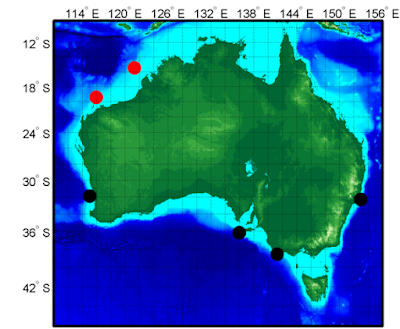Deployment Map A. (above) of key acoustic sensor sites
currently sampled for sea noise by IMOS (black) and the North Western Australia
locations (red) which ceased [civilian?] operation in mid 2015.
---
Map B. (above) IMOS about: "The Australian Ocean Data Network (AODN) Portal (http://portal.aodn.org.au ) allows marine and climate scientists and other users to
discover and explore IMOS data streams coming from all of these
Facilities."
---
So how do the sensor network locations on the maps above compare with map below? :
Map C. (above) is from page 54 “Map 4. The US ‘Fish Hook’ Undersea Defense Line” of Desmond Ball and Richard Tanter's, The Tools of Owatatsumi Japan’s Ocean Surveillance and Coastal Defence Capabilities (2015, ANU Press) http://press-files.anu.edu.au/downloads/press/p309261/pdf/book.pdf?referer=444. [large PDF file] This map, looking highly sanitised, may depict past or current SeaWeb undersea array positions (eastern Asia - inner western Pacific sub-section).
COMMENT
In plain sight is Australia's Integrated Marine Observing System (IMOS).
IMOS includes Australia's dual (civilian, military) use passive acoustic undersea network and many other ocean sensor platforms. This includes RAN operated AUVs. Here is IMOS's facilities list http://imos.org.au/facilities.html - very much an Australian dual-use portion of the wider allied with the US SeaWeb sensor-database network.
IMOS includes a National Mooring Network with passive acoustic observatories that are fairly submarine relevant - see Deployment Map A.
Unsurprisingly two of IMOS "Operational Partners" are the:
· Argo – Co-investment
in Argo floats and deployment of floats
· Expendable
bathythermograph -
supply the majority of the XBT probes deployed under co-investment
· AUV – support for MV Kimbla [als see old RAN website "HMAS" Kimbla] used for
pre-trial engineering deployments in 07/08
· AODN – personnel support”
and
[Department of] "Defence Science
and Technology Group (DST Group)
DST Group is the Australian government's lead
agency responsible for applying science and technology to safeguard Australia
and its national interests. As one of Australia’s largest employers of
scientists and engineers, it delivers expert, impartial advice and innovative
solutions for Defence and national security.
· Autonomous
Underwater Vehicles (AUV) – Research fellow funding
· Acoustic Observatories – Funded for pilot deployment
of three sea noise loggers in Perth Canyon, Jan-Apr 2007 and then assisted
further with logger development
· Ocean
gliders (ANFOG) – Slocum glider data from the oceans
around Australia have been collected by DSTO on an ongoing basis with
previous deployments contributed to the IMOS Ocean Portal including: Coral Sea
deployment during Exercise Talisman Sabre in July 2011, Coral Sea deployment,
adjacent to Shoalwater Bay, during Exercise Talisman Saber in July - August
2013, and a Perth Canyon deployment, during a combined ocean glider deployment
in conjunction with the IMOS ocean glider facility, in February - March
2014"
Pete














